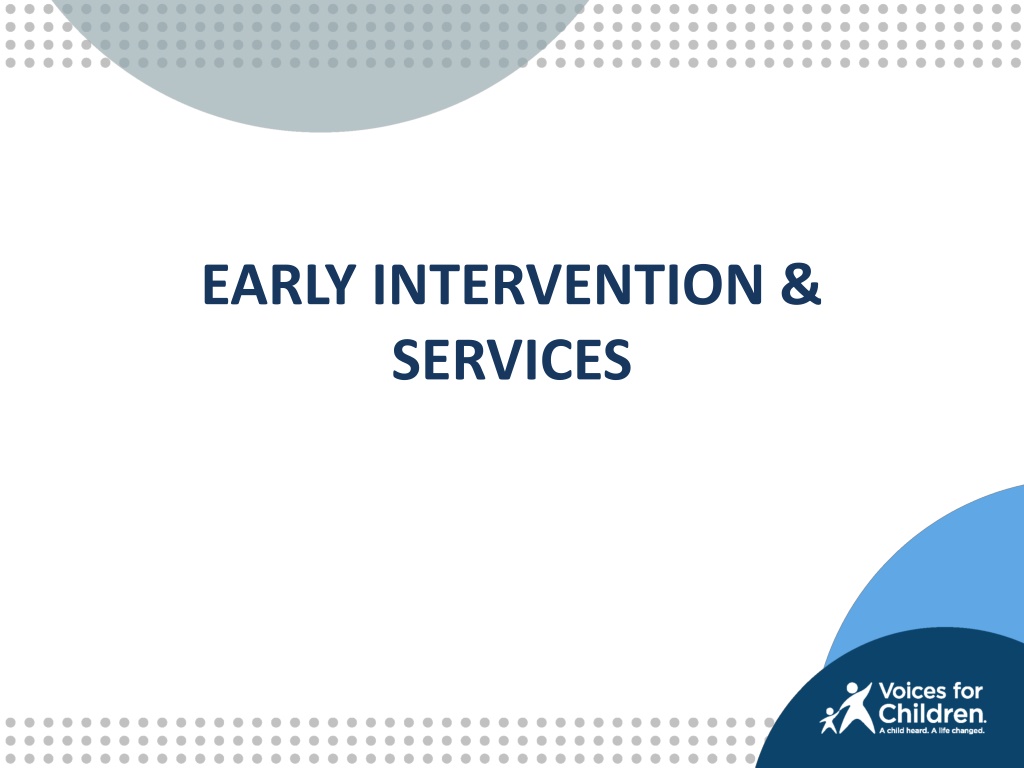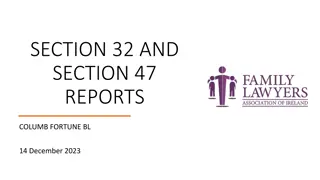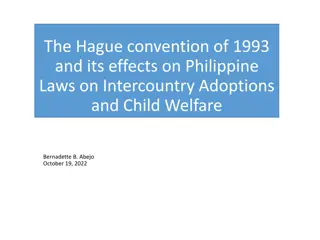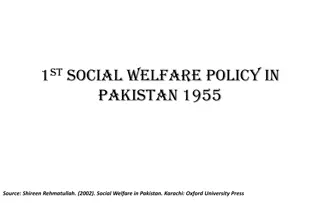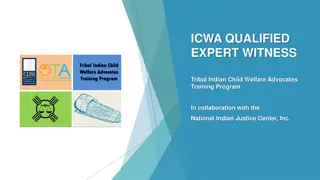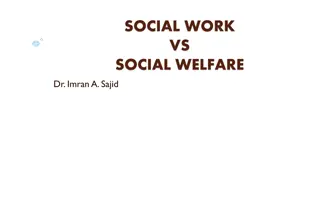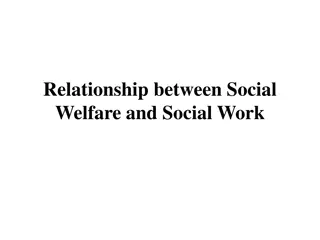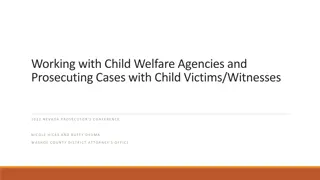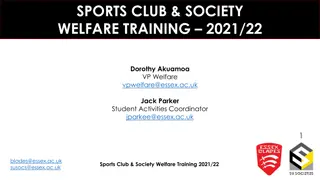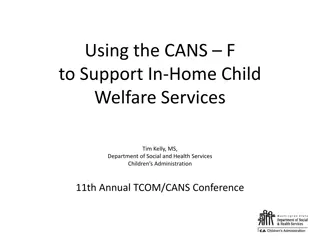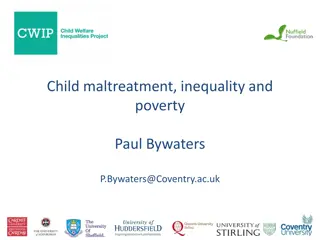Child Welfare Services Overview
Child welfare services involve early intervention for children entering the dependency system, focusing on age-appropriate services, foster care dynamics, a dependency timeline post-reunification, WIC codes for various cases, reports by social services practitioners, and detention reports. The system emphasizes timely intervention, reunification efforts, and permanent plan determination post-reunification services.
Download Presentation

Please find below an Image/Link to download the presentation.
The content on the website is provided AS IS for your information and personal use only. It may not be sold, licensed, or shared on other websites without obtaining consent from the author. Download presentation by click this link. If you encounter any issues during the download, it is possible that the publisher has removed the file from their server.
E N D
Presentation Transcript
EARLY INTERVENTION & SERVICES
Todays Agenda Court Services- Intervening as soon as the child enters the dependency system, regardless of their age Age Appropriate Services Infants and young adults and the resources available
Children in Foster Care What ages of children are most likely to be removed from their home? What ages of children are most likely to reunify with their parents and then reenter foster care a second time?
Dependency Timeline Takes place 120 days after reunification services are terminated Reunification Determines Permanent Plan: - Adoption - Guardianship - APPLA Reunification services can be terminated at the 6MRH, 12MRH, or 18MRH. If reunified, Family Maintenance services start. If fail to reunify a 366.26 hearing is set Post Permanency Planning Review* Referral Call Disposition* 6 Month Review 12 Month Review 18 Month Review Jurisdiction/ 366.26 Detention Petition Filed CASA Report CASA Report CASA Report CASA Report CASA Report *Contested Hearings: CASAs may not attend any trials after the J/D hearing * PPPR Hearings: Take place every 6 months until jurisdiction is terminated
WIC Codes 300(a) Physical abuse 300(b) Neglect cases 300(c) Emotional harm cases 300(d) Sexual abuse 300(e) Severe physical abuse for kids under 5 300(f) Parent caused the death of another child 300(g) Incarcerated parents who can t arrange care; missing parents 300(h) Freed for adoption 300(i) Acts of cruelty 300(j) Parents abused or neglected a sibling
Social Services Practitioners Reports Written before every hearing includes details of case history, type and # of placements, update on the child and family, case plan goals, and recommendations. The length of a social services practitioner s report can be 15-40 pages Your Advocacy Supervisor will send the Detention, JD, and most recent reports upon your assignment.
Detention Report First Report for the first hearing Must be ready for hearing held 72 hours (3 days) after removal At the hearing court assigns attorneys, decides visitation for the parents and decides if child stays in home or should be removed Factual, includes allegations, and parents comments regarding allegations Indicates which WIC 300 codes they based the petition for removal
Jurisdiction/Disposition Report Within the month from the Detention hearing, social services practitioner thoroughly investigates the alleged WIC 300 letters. MUCH longer report. Will include each person s thoughts on the specific WIC codes, a recommended case plan and may contain photographs. It is at this stage parents are likely to contest, or disagree, with the allegations any or all. Oftentimes, DPSS and the parties attorneys will come to an agreement without having to have a trial and this is when the allegations will be finalized.
Jurisdiction Disposition Report If the petition is not true: - it will be dismissed. The court only has to find one of the allegations true to take Jurisdiction. If (b1) (b2) and (b3) are alleged and only (b1) is found true, that s enough.
Addendums If, however, the parties can t agree, the Court will then set a date for a contested hearing. For that hearing the social services practitioner will write an Addendum to their original Jurisdiction Disposition Report bringing forth more evidence to show why all allegations are true. The parents can have a trial, bring witnesses, and present evidence to show they are not true. You can find the agreed upon WIC 300 allegations in the minute order for the last Juris/Dispo hearing. It will have been adjudged true .
This or That Segment Test your wits! These words are very similar and easy to confuse but vastly different in practice. Partner up and you have three minutes to correctly match.
Five Areas of Child Development Social/Emotional - interactions & behavior Speech & Language - expressive & receptive Cognition - understanding of world Fine Motor - small muscles Gross Motor - large muscles Developmental Delay: When a child does not reach developmental milestones by the expected time period
Developmental/Behavior Resources in the Community Department of Behavioral Health First 5 Riverside HeadStart Inland Regional Center Wraparound
Therapy Referrals Physical - addresses trouble with large muscle groups that contribute to mobility, e.g. issues standing, balancing, walking Occupational works to help accomplish daily activities, e.g. cooking, bathing, dressing Speech focuses on inconsistent/incorrect production of speech sounds Language addresses trouble understanding others (receptive) or sharing thoughts (expressive) Behavioral replaces bad habits with good, builds coping skills Parent/child interaction combo of behavioral therapy, play therapy, and parent training
Common Diagnoses Your case child may be diagnosed with Bipolar Disorder Attention Deficit Hyperactivity Disorder (ADHD) Posttraumatic Stress Disorder (PTSD) Oppositional Defiant Disorder (ODD) Anxiety Depression Reactive Attachment Disorder
Introduction to JV220 forms Whenever a doctor recommends a child take prescription medications, it s reviewed by another doctor and a judge must approve. The authorization only lasts 6 months before it must be reviewed again. Your supervisor will send you any updates submitted to the court and can provide further guidance on what dosages are typical. Additional interventions should be occurring alongside medications.
How CASAs Can Advocate Follow-up on the services your case child was referred to Communicate with your supervisor, the social services practitioner, and minor s attorney if your case child should be receiving services and is not receiving them. Close the loop in the communication circle. Inquire about what concerns the caregiver, parents, teachers, etc may have and gather documents regarding the child s participation and progress. In your court report explain your case child s concerns and any barriers that may be preventing them from receiving services Model appropriate boundaries
VFC Infants and Toddlers Policies CASAs visit case children ages 0 to 5 at their placement, daycare, appointments, etc. CASAs may not transport children ages 0 to 5 unless under special circumstances with prior approval from their Advocacy Supervisor CASAs will use car seats and booster seats in accordance with state law VFC can help provide car/booster seats, if needed
Activities for In-Home visits Bring fun bag filled with activities/crafts Favorite books Easy puzzles Stickers or Magazines to make a mood board Cook or bake- waffles, cupcakes, or burritos Board games, backyard sports Arts, crafts, or building kits
Adoptions Overview All homes are now called Resource Families no distinction between foster homes and relative caregivers Homes must have a Resource Family Assessment (RFA), formerly home study, before reimbursement can begin this often takes 60-90 days. Families are therefore motivated to move the process along in order to get reimbursement. Starting in 2017, all Resource Families are going through same process, regardless of whether they want to foster or adopt. When a case goes to adoption the RFA is already done and the adoption can move much faster
Adoptions Process The Telling All known medical and social history of the child Read to adoptive family CASAs may not attend If there are any concerns (even speech therapy), there must be a current evaluation (meaning within a year) for adoption to be finalized Almost all cases are appealed they have up to 60 days to do so. The appeal can take up to 12 months and nothing can happen while there is an active appeal Adoption Finalization Hearing
CASA Role to Seek Permanency Check in with family Manage stress CASA can explain timeline and follow-up on service referrals Advocate for them to have necessary documents/paperwork e.g., passport, birth certificate Monitor progress of required steps Facilitate communication between DPSS and contracted parties Follow up on estimated dates of completion End goal: are we ready?
What if were not early? We serve dependents age 0-21 Young adults, age 18+ can benefit from a CASA! Extended Foster care includes young adults ages 18 until 21 To participate, young adults must meet criteria Youth can also decide if they want to work with a CASA Requires a Non-minor Dependent Consent form NMD s attorneys are no longer their Guardian Ad Litem Extra patience in this process is essential
What is Attachment? The brain is hard-wired to create an emotional bond with a caregiver from the moment we are born Secure attachments form when a parent or caregiver responds sensitively and consistently to a child s needs Insecure attachments can form when a parent or caregiver responds inconsistently or not at all to a child s needs
Boundaries Children who have been abused expect trauma to be repeated and this expectation permeates their relationships Relationships are organized around the expectation or prevention of victimization: clinginess, oppositional defiance, distrust Children who have been abused and neglected often exhibit inappropriate boundaries; they may bond right away or not at all Why is it important that we discuss boundaries and attachment?
Sapphire Mother s drug use brought Sapphire to Court s attention when she was three years old. She was undernourished and self-biting. Grandma became her legal guardian for nine years, then asked Court to care for her. CASA was assigned during reunification process with legal guardian.
CASAs Role How did the CASA advocate for Sapphire leading up to the hearing? Connected with team: caregiver, teachers, doctor, social services practitioner, grandmother, and Sapphire! Followed up on services: asked about medication, progress in therapy, education, and visits. Wrote a comprehensive and detailed CASA report for the Court What do you think CASA will recommend? Move visits to closer location Consider a different time frame for visits or a math tutor Continue reunification services
Sapphire Update After six years of advocacy, Sapphire is now in high school. She lives in a resource family home and is doing well in school. Her CASA remains a steady support and holds ed rights. Sapphire now willingly reports her grades and talks about academics with her CASA. Sapphire s adult sister has continued positive contact and Sapphire may visit her out of state over spring break.
